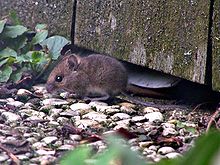Muridae
| Muridae Temporal range: Early Miocene – Recent |
|
|---|---|
 |
|
| Wood mouse, Apodemus sylvaticus | |
| Scientific classification | |
| Kingdom: | Animalia |
| Phylum: | Chordata |
| Class: | Mammalia |
| Order: | Rodentia |
| Superfamily: | Muroidea |
| Family: |
Muridae Illiger, 1811 |
| Subfamilies | |
The Muridae, or murids, are the largest family of rodents and of mammals, containing over 700 species found naturally throughout Eurasia, Africa, and Australia.
The name Muridae comes from the Latin (genitive ), meaning "mouse".
Murids are found nearly everywhere in the world, though many subfamilies have narrower ranges. Murids are not found in Antarctica or many Oceanic Islands. Although none of them are native to the Americas, a few species, notably the house mouse and black rat have been introduced worldwide. Murids occupy a broad range of ecosystems from tropical forests to tundras. There are fossorial, arboreal, and semi-aquatic murid species, though most are terrestrial. The extensive list of niches filled by murids helps to explain their relative abundance.
There are a broad range of feeding habits found in murids, ranging from herbivorous and omnivorous species to specialists who consume strictly earthworms, certain species of fungi, or aquatic insects. Most genera consume plant matter and small invertebrates, often storing seeds and other plant matter for winter consumption. Murids have sciurognathous jaws and a diastema is present. Murids lack canines and premolars. There are generally three molars (though sometimes only one or two) and the nature of the molars varies by genera and feeding habits.
Some murids are highly social while others are solitary. It is common for females to produce several litters annually. In warm regions, breeding may occur year-round. Though the lifespan of most genera is generally less than two years, murids have high reproductive potential and their populations tend to increase rapidly and then drastically decline when food resources have been exhausted. This is often seen in a three to four-year cycle.
The murids are small mammals, typically around 10 cm (3.9 in) long excluding the tail, but ranging from 4.5 to 8 cm (1.8 to 3.1 in) in the African pygmy mouse to 48 cm (19 in) in Cuming's slender-tailed cloud rat. They typically have slender bodies with a scaled tail longer than the body, and pointed snouts with prominent whiskers, but with wide variation in these broad traits. Some murids have elongated legs and feet to allow them to move with a hopping motion, while others have broad feet and prehensile tails to improve their climbing ability, and yet others have neither adaptation. They are most commonly some shade of brown in colour, although many have black, grey, or white markings.
...
Wikipedia
